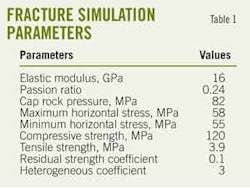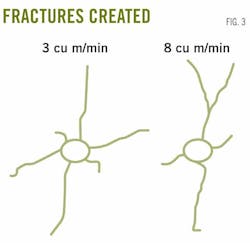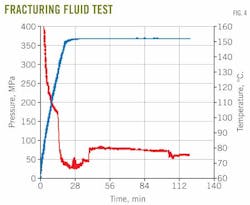Model optimizes sandstone-conglomerate fracturing in China
View Article as Single page
Simulation model
Reservoir permeability decreases from west to east and increases from the edge to the center in the south-north direction. The heterogeneity coefficient and permeability differential are 1.2 and 1.5, respectively.
In the vertical direction, reservoir permeability decreases from top to bottom.
Parameters in the simulation model included the permeability distribution, oil viscosity, oil saturation, effective thickness, fracture length, fracture height, fracture conductivity, and data from five exploration wells.
The simulation used a multifactor sensitivity analysis for obtaining a suitable reservoir production model.
The model size was 50 by 350 by 120 m, and contained 23,100 (55 by 35 by 12) grids. The fracture orientation used was northeast 110°.
A local infill grid (2 by 2 by 2 m) improved the fracture grid.
A multifactor regression analysis established the reservoir production model with seven parameters in Equations 1-3 (see equation box).
According to the simulation, the optimum fracture parameters were 145-75 m length, 50-70 m height, and 10-15 μm2/cm conductivity.
A Weibull distribution described rock heterogeneity (Equation 4).
In the equation, α is the mechanics parameter such as strength, elastic modulus etc. The α0 is the average value of mechanics parameter, m is heterogeneity coefficient, and ψ(α) is the statistical distribution density. A larger homogeneity coefficient indicates a less homogeneous rock.
The distribution of reservoir parameters in the horizontal and vertical directions was forecast based on reservoir heterogeneity and well log data from five exploration wells. Table 1 lists the rock’s mechanical parameters required by the software for the glutenite reservoir .
Fig. 3 shows the finite element model of the hydraulic fracture, and Fig. 4, the fractures created with injection rates or 3.0 cu m/min and 8.0 cu m/min.
With the higher injecting rate, the fracture extension is less in the horizontal direction but much larger in the vertical direction. This means that the job created multifractures with a low average fracture conductivity.
When the rock had strong heterogeneity and a large difference between maximum and minimum horizontal stress, the fracture extension was straight. The random distribution of rock grains will make the stress nonuniform in the reservoir and create a high stress in a local area, which results in fracture extensions along the low stress direction.




